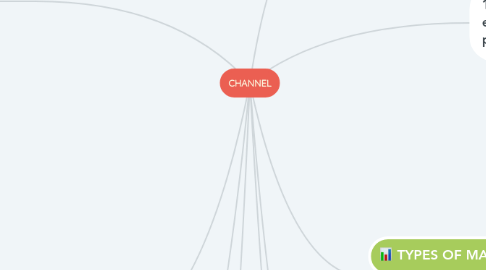
1. ALTERNATIVE MARKETING CHANNEL
1.1. CUSTOMER GOOD
1.1.1. 1. Producer > customer
1.1.2. 2. Producer > retailer > customer
1.1.3. 3. Producer > wholesaller > retailer > customer
1.1.4. 4. Producer > agents > wholeseller > retailer > customer
1.2. BUSINESS GOOD
1.2.1. 1. Producer > business user
1.2.2. 2. Producer > agent > business user
1.2.3. 3. Producer > wholesaller > business user
1.2.4. 4. Producer > agent > wholeseller > business user
1.3. SERVICE
1.3.1. 1. Service provider > consumer / business user
1.3.2. Service provider > agent > consumer / business user
2. DETERMINING DISTRIBUTION INTENSITY
2.1. 1. Intensive distribution - Distribution of a product through all available channels
2.2. 2. Selective distribution - Distribution of a product through a limited number of channels
2.3. 3. Exclusive distribution - Distribution of a product through a single wholesaler or retailer in a specific geographic region
2.3.1. LEGAL PROBLEM
2.3.1.1. 1. Exclusive dealing agreement
2.3.1.2. 2. Closed sales territories
2.3.1.3. 3. Trying agreements
3. LOGISTICS AND SUPPLY CHAIN MANAGEMENT
3.1. 1. RADIO FREQUENCY IDENTIFICATION (RFID) - Technology that uses a tiny chip with identification information that can be read by a scanner using radio waves from a distance
3.2. 2. ENTERPRISE RESOURCE PLANNING - Software system that consolidates data from among a firm’s various business units
3.3. 3. LOGISTICAL COST CONTROL - The distribution function accounts for half of a firm’s total marketing costs
4. CLASSES OF CARRIER
4.1. 1. Common carriers - Provide transportation services as for-hire carriers to the general public.
4.2. 2. Contract carrier - For-hire transporters that do not offer their services to the general public
4.3. 3. Private carrier - Provide transportation services solely for internally generated freight.
5. 1. DIRECT SELLING - Strategy designed to establish direct sales contact between producer and final user.
6. MEANING : System of marketing institutions that enhances the physical flow of goods and services, along with ownership title, from producer to consumer or business user.
6.1. FUNCTION :
6.1.1. 1. Exchange process by reducing the number of marketplace contacts necessary to make a sale
6.1.2. 2. Adjusting for discrepancies in the market’s assortment of goods and services via sorting
6.1.3. 3. Standardizing exchange transactions by setting expectations for products
6.1.4. 4. Facilitating searches by both buyers and sellers
7. TYPES OF MARKETING CHANNEL
7.1. RESELLER
7.1.1. 1. Retailer - A person or business that sells goods to the public in relatively small quantities for use or consumption rather than for resale.
7.1.2. 2. Wholeseller - A person or company that sells goods in large quantities at low prices, typically to retailers.
7.2. BROKER - A person who buys and sells goods or assets for others.
7.2.1. 1. Agent - A person who acts on behalf of another person or group.
7.3. FACILITATORS
7.3.1. 1. Tranportation companies

